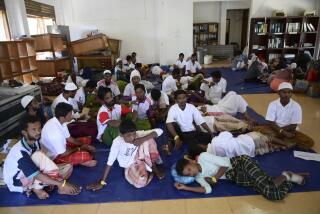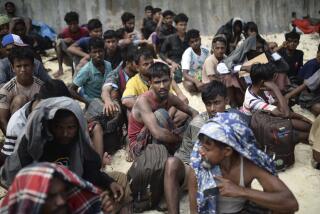Southeast Asia refugee crisis has reached ‘alarming level,’ meeting hears
The influx of refugees “has reached an alarming level,” Thailand’s Foreign Minister General Tanasak Patimapragorn said Friday as representatives from 17 countries gathered at a Bangkok hotel to discuss a crisis that has engulfed the region for weeks.
About 3,500 migrants have arrived in Thailand, Indonesia and Malaysia, after either washing up on the shore or being rescued at sea by local fishermen. Scores of others are thought to be adrift on the Andaman Sea and in the Bay of Bengal with dwindling supplies of food and water.
“No country can solve this problem alone,” Tanasak said in introductory remarks at the Anantara Siam, a luxury Bangkok hotel with perfumed lobbies and lush garden courtyards.
Most of the migrants are Rohingya Muslims from Myanmar’s western Rakhine state, widely considered one of the world’s most persecuted minorities. Other migrants are Bangladeshi, fleeing desperate poverty at home. Many have spoken of torture and starvation at sea.
Delegates to Friday’s meeting included high-ranking officials from countries affected by the crisis, as well as the United States, Switzerland, Japan and a handful of international organizations.
The meeting yielded a list of policy recommendations, but no breakthrough agreements.
“I think the problem is that these governments are viewing these movements of people on boats through a security prism rather than a humanitarian prism,” said Phil Robertson, deputy director of Human Rights Watch’s Asia division.
The meeting began with a tense back-and-forth between the United Nations assistant high commissioner for refugees, Volker Turk, and Myanmar’s delegate, Foreign Ministry Director General Htin Lynn.
Turk said that Myanmar should shoulder “full assumption of responsibility … toward all its people.”
Htin Lynn shot back: “Finger pointing will not serve any purpose.”
“It will take us nowhere,” he said.
Myanmar refuses to grant the Rohingya citizenship, leaving them effectively stateless. Since a spate of ethnic violence in 2012, an estimated 140,000 of them have been living in ghettos with poor nutrition, poor sanitation and few political rights. Officials call the group “Bengali Muslims,” implying that they immigrated to Myanmar from Bangladesh.
At least 100,000 Rohingya have fled the country by boat since 2012, according to the Arakan Project, a Bangkok-based nonprofit that tracks migration in the region.
Htin Lynn did not mention the word “Rohingya” in his opening remarks. The U.N. should ‘’be more informed,” he said.
Myanmar’s navy found 727 people packed onto a fishing boat, the country’s Ministry of Information said in a Facebook post on Friday, referring to the human cargo as “Bengali.” The migrants, who included 45 children, were arrested, the brief post said.
Myanmar is not alone in deflecting responsibility for the crisis.
Indonesia and Malaysia — both on the crisis’ front lines — did not send ministerial-level delegates to Friday’s meeting.
They have agreed to take migrants in for up to a year before they are resettled elsewhere, and both countries have ordered search-and-rescue missions. But about 2,600 people could still be adrift, according to U.N. estimates.
“It’s kind of like when you go shopping in a glass store with a 5-year-old, the principle is ‘you break it, you own it,’” Robertson said. “In this sense, it’s ‘if you find it, you own it.’ So they want the other guys to find the boatload of Rohingya.”
“It’s like an Easter egg hunt where nobody wants to find the eggs,” he added.
Thailand has yet to reverse a long-held policy of turning back migrant boats that enter its waters. On Wednesday, Bangladesh announced plans to move Rohingya refugees within its borders to an island off the country’s southern coast, where critics say they will face extremely poor living conditions.
Experts say that the crisis began in early May, when the Thai government cracked down on smuggling networks after finding a series of mass graves in the country’s south. The move wreaked havoc in the multimillion-dollar human trafficking industry, leading many smugglers to abandon their human cargo mid-journey.
The situation at sea remains unclear.
“We started off as saying there were 6,000 to 8,000 [migrants] at sea, and about 4,000 have landed. Where’s the balance?” said Joe Lowry, a spokesperson for the International Organization for Migration. “If nobody’s being found, we wonder if the search and rescue isn’t adequate, or if there’s no one else to find.”
Follow @jrkaiman on Twitter
More to Read
Start your day right
Sign up for Essential California for news, features and recommendations from the L.A. Times and beyond in your inbox six days a week.
You may occasionally receive promotional content from the Los Angeles Times.






